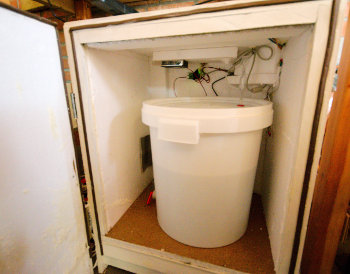September was warmish in many places around the world including [Ole]’s native Denmark. But that did not stop him from brewing lager flavored with plums from his own garden, and neither did his indifference to lagers in general.
Lager fermentation requires a consistent, low temperature. While many homebrewers might modify an electric refrigerator, [Ole] wasn’t interested in the cost of running a second one just for brewing beer. Instead, he built a climate box to work with the cool temperature in his garage. Starting with scrap wood from other projects, he lined the walls with polystyrene and put a layer of wood on the floor to help support the fermentation bucket.
Maintaining a consistent temperature in the box called for both heating and cooling. He pulled the Peltier from a 12V cooler meant to run off a car’s cigarette lighter, and used a spare ceramic heater that was lying around in case his primary reptile warmer went on the fritz.
An Arduino and a custom shield drive separate PID controllers for the Peltier and the heater. The shield has a temperature probe, and he extended the USB outside the climate box so the PIDs can be adjusted without disturbing the inside temperature. The schematic, board file, and code are all available in a zip you can get from his post.
The Peltier couldn’t quite compensate for the overly warm weather and the heat caused by the fermentation, but it was stable enough to produce a nice, plum-flavored lager he has dubbed Lektor Blommes maltbolche, which is a triple Danish pun he explains in the write-up.
















Nice! But (and someone please tell me if this is not feasible) couldn’t he have used the peltier to cool and heat? I was under the impression they can do both.
Some of the cheap peltier cooler boxes have a heating mode which just reverses the voltage to the TEC. I have no idea if this is bad for the TEC or not but you could switch between heating and cooling with an H bridge.
Since compressors are more efficient at cooling than TECs at present a small fridge run at a temperature close to ambient might not be more power hungry and would be better at keeping up with the heat of the initial fermentation. You could try to improve the insulation if you were worried.
wtf, he doesn’t want to run a fridge but he’ll run a Peltier cooler instead? Can someone please tell this man (or HaD) about thermodynamics?
And that you can reverse the current through a peltier to make it pump heat into the box, so no additional heating element is required unless you want to heat at a much higher rate.
You don’t need any particular knowledge about thermodynamics to read the efficiency rating in a datasheet. In fact, I’m quite sure a degree involving thermodynamics won’t tell you those numbers either.
A compressor is more efficient than a Peltier element, but the size of the compression cooler and its start-up heat loss might actually cause higher losses in the end: it won’t help if the efficiency of a compression cooler is 50% if it happens to drain much more power than the low-efficiency Peltier element. It’s the absolute loss that counts, not the relative loss.
The current can be reversed, but then a H-bridge would incur two transistor losses whereas a relay provides the Peltier element with the full voltage.
Which, I presume, is why we’re all using Peltier-cooled refrigerators.
Except, we’re not.
Peltiers are useful in a small and no-moving-parts sort of way, but they’re always less efficient than compressors in terms of total energy input vs. total energy transferred.
Refrigerating a small insulated box with a container of liquid is a solved problem. Compressors won*. Yes, there’s startup loss at every startup, but that can be minimized by choosing an appropriate compressor.
You want the thing to have long cycles, not short cycles. Peak efficiency is at 100% duty cycle, so for applications like this, less capacity is more is more efficient.
Also, FFS, it’s got a microcontroller. Cycle time can be -anything-.
*: See kitchen.
(Oh, and did I see that the Peltier wasn’t even up to the job? Nice fail at reinventing refrigeration.)
Gee, we’re friendly today, aren’t we? Longer cycle times means increased temperature variation. As for the efficiency of Peltier elements versus compressors, see the previous commdent.
Actually, the Peltier element was up to the job. I had merely expected the ambient temperature to be lower. These days the average outside temperature is as low as I had originally expected, and the cooler wakes up only occasionally. Nice fail at being sarcastic.
Use good MOSFETs, and then you only have minimal losses.